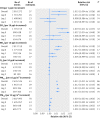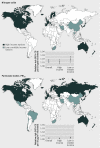Short term exposure to air pollution and stroke: systematic review and meta-analysis
- PMID: 25810496
- PMCID: PMC4373601
- DOI: 10.1136/bmj.h1295
Short term exposure to air pollution and stroke: systematic review and meta-analysis
Erratum in
-
Short term exposure to air pollution and stroke: systematic review and meta-analysis.BMJ. 2016 Sep 6;354:i4851. doi: 10.1136/bmj.i4851. BMJ. 2016. PMID: 27600637 No abstract available.
Abstract
Objective: To review the evidence for the short term association between air pollution and stroke.
Design: Systematic review and meta-analysis of observational studies
Data sources: Medline, Embase, Global Health, Cumulative Index to Nursing and Allied Health Literature (CINAHL), and Web of Science searched to January 2014 with no language restrictions.
Eligibility criteria: Studies investigating the short term associations (up to lag of seven days) between daily increases in gaseous pollutants (carbon monoxide, sulphur dioxide, nitrogen dioxide, ozone) and particulate matter (<2.5 µm or <10 µm diameter (PM2.5 and PM10)), and admission to hospital for stroke or mortality.
Main outcome measures: Admission to hospital and mortality from stroke.
Results: From 2748 articles, 238 were reviewed in depth with 103 satisfying our inclusion criteria and 94 contributing to our meta-estimates. This provided a total of 6.2 million events across 28 countries. Admission to hospital for stroke or mortality from stroke was associated with an increase in concentrations of carbon monoxide (relative risk 1.015 per 1 ppm, 95% confidence interval 1.004 to 1.026), sulphur dioxide (1.019 per 10 ppb, 1.011 to 1.027), and nitrogen dioxide (1.014 per 10 ppb, 1.009 to 1.019). Increases in PM2.5 and PM10 concentration were also associated with admission and mortality (1.011 per 10 μg/m(3) (1.011 to 1.012) and 1.003 per 10 µg/m(3) (1.002 to 1.004), respectively). The weakest association was seen with ozone (1.001 per 10 ppb, 1.000 to 1.002). Strongest associations were observed on the day of exposure with more persistent effects observed for PM(2·5).
Conclusion: Gaseous and particulate air pollutants have a marked and close temporal association with admissions to hospital for stroke or mortality from stroke. Public and environmental health policies to reduce air pollution could reduce the burden of stroke.
Systematic review registration: PROSPERO-CRD42014009225.
© Shah et al 2015.
Conflict of interest statement
Competing interests: All authors have completed the ICMJE uniform disclosure form at
Ethical approval: Not required.
Figures



Comment in
-
Air pollution, stroke, and anxiety.BMJ. 2015 Mar 24;350:h1510. doi: 10.1136/bmj.h1510. BMJ. 2015. PMID: 25810500 No abstract available.
-
[Environmental medicine: air pollution promotes strokes].Dtsch Med Wochenschr. 2015 May;140(10):708-9. Dtsch Med Wochenschr. 2015. PMID: 26171471 German. No abstract available.
References
-
- Brook RD, Rajagopalan S, Pope CA, 3rd, et al. Particulate matter air pollution and cardiovascular disease: an update to the scientific statement from the American Heart Association. Circulation 2010;121:2331-78. - PubMed
-
- Mustafic H, Jabre P, Caussin C, et al. Main air pollutants and myocardial infarction: a systematic review and meta-analysis. JAMA 2012;307:713-21. - PubMed
Publication types
MeSH terms
Substances
Grants and funding
LinkOut - more resources
Full Text Sources
Other Literature Sources
Medical
